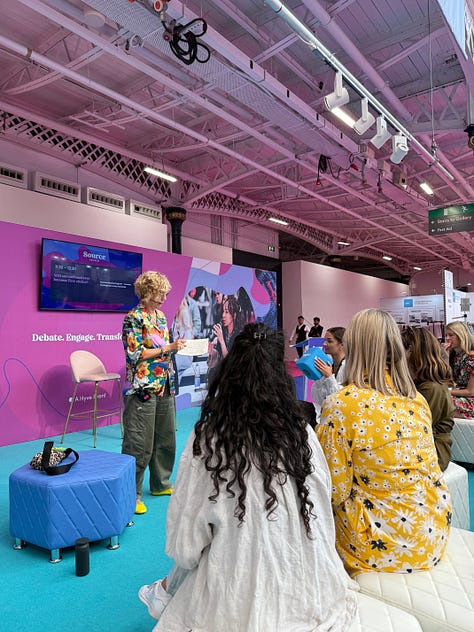Is Fashion's Future Secondhand?
What do you think? Sustainable Transition Plans for Fashion highlight circular business models, especially resale, as ways to reduce fashion's carbon emissions but is that really possible?
Sustainable Transition Plans for fashion and textiles highlight circular business models, particularly the secondhand market as one of the ways we can reduce the fashion industry’s overall environmental impact and its carbon emissions. The British Fashion Council’s Institute of Positive Fashion wants a quarter of our wardrobes to be secondhand by 2030. ReLondon say that transitioning 25% of Londoner’s apparel purchases to be secondhand, in combination with increasing repairs, would reduce emissions by 30% and in their Fashion on Climate Report Mckinsey say that to meet the targets set in the Paris Climate Accord one in five apparel purchases need to be through circular business models by 2030. But is that really possible?
Can Fashion’s Future be Secondhand?
What do you think? I think could be possible, but I also think a lot more discussion is needed to understand how the exponentially growing secondhand apparel market - the latest ThredUp Resale Report predicts it will more than double this decade from $141 billion in 2021 to $367 billion by 2029 - can disrupt the fashion system and how we can ensure a secondhand future is a good thing for people and the planet.
So, I was delighted when Source Fashion invited me to Olympia this week to host a debate asking fashion industry professionals if fashion’s future is going to be secondhand? Huge thanks to everyone who came along and joined in what turned into a very lively debate! As always I’m sharing my key takeaways below…



Is a secondhand future possible?
Interestingly, despite everyone in the audience saying they personally shopped secondhand, at the start of the debate most people thought that meeting the targets in the sustainable transition plans was NOT possible. There was a sense that fashion insiders, or people who care about sustainability, shop secondhand but ‘most’ people don’t and getting everyone to embrace a preloved future would be really difficult.
A counter argument to this was a definite sense that secondhand was becoming more normalised, with participants sharing stories about how their children regularly shopping preloved stuff instead of new and resold their old clothes to fund more secondhand purchases.
Stories like these give me hope that a new generation growing up within the circular economy could be the stepping stone to a circular future. What do you think?
Why shop secondhand?
The majority of the audience shopped secondhand because it was more fun than shopping new! This connects with research suggested the thrill of finding unique secondhand treasure, especially if you think it’s a bargain, releases positive endorphins in our brains and is addictive! Sustainability was the second most popular motivation and this combined with the sense it’s a good thing to do and being proud to tell people you’re wearing secondhand all added to the positive endorphin effect!
While price wasn’t the main motivation yesterday, secondhand was seen as a way to buy ‘better’ quality clothes or trade up to brands you couldn’t afford new. There was also a feeling that prices were going up - particularly in charity shops - and secondhand was becoming less affordable for lots of people.
Is the future of resale digital?
If you believe the fashion business press Gen Z and Millenials are the future of secondhand shopping and it does seem likely that they are driving the growth in online resale platforms both as active shoppers and as the most active resellers too.
However, many of yesterday’s audience had been shopping secondhand for more than 20 years and lots of people still preferred shopping secondhand in physical stores so they could see the quality, feel the fabric and try things on before they buy.
Online platforms were seen as good for inclusivity and accessibility - especially around fringe sizes - and also good because they represent different levels of the market and that makes reselling or finding something specific easier.
What about the elephant in the room?
I asked if shopping secondhand was sustainable and most people thought it was but some of the audience were also worried about resale fuelling overconsumption. There were really interesting debates about whether it’s ok to buy things to resell, and whether knowing you could easily resell something if you didn’t like it was making us all more reckless shoppers?
The good news is that for us, as individuals, shopping secondhand instead of buying something new definitely does reduce our own personal carbon footprints.
But my MA research also suggested that the ability to resell, or donate, our unwanted clothes and feel like we’re doing a ‘good’ thing at the same time is encouraging people to buy even more stuff - both new and secondhand.
And that’s a problem because for the secondhand market to reduce the overall fashion industry’s carbon emissions, all our secondhand purchases need to physically replace or displace new purchases and brands need to manufacture fewer new clothes. And I can’t find any evidence of this displacement happening - can you?
How can we measure displacement?
The other elephant in the room is that brands don’t reveal how many clothes they’re producing - see the The Or Foundation Speak Volumes Campaign - and once clothes enter the secondhand market they’re generally quantified by value or weight. That means there’s no way to compare the numbers and it’s impossible to accurately measure whether secondhand sales are displacing new sales - or not!
Currently the only way measure displacement is by asking people about their shopping habits - if you’re interested Wrap have developed a methodology for doing exactly this. Their survey results suggest that ‘over 3 in 5 secondhand purchases displace new’ ones. While this sounds like a really positive statistic it raises the question that is those 3 items really were displacing new purchases….
Wouldn’t brands need to make 60% less new stuff? Or am I missing something?
What wouldn’t you buy secondhand?
All the usual answers - underwear, swimwear, shoes! And fast fashion….
Is this the biggest elephant in our wardrobes?
I think the biggest elephant in our wardrobes is that most of the sales volume in the fashion industry is happening at lower prices - from brands like H&M, Zara, Shein and Primark - and that’s not what most people want to buy secondhand. The majority of secondhand shoppers I speak to, myself included, want to buy ‘better’ quality clothes.
But my worry is that if we don’t all start buying secondhand fast fashion what’s going to happen to the 105.1 million Zara items or the 95.3 million H&M items or the 34.4 million Shein items or the 34.2 million Primark items on Vinted yesterday…. Are all these clothes all heading straight to landfill?
So is fashion’s future secondhand?
I asked the same question at the end of the hour and while a few more people thought it could be possible, the majority remained unconvinced. I’m hoping Source will let me come back next year, and the year after, to keep doing a temperature check on how attitudes are changing…
But meantime, what you think? Is fashion’s future secondhand?



I think a big part of fashion's future will be secondhand. I've bought secondhand Zara myself and know other people who will buy some of the fast fashion brands.
I admit to not being "fashionable" but I do have my own style and I'm unlikely to see anyone else dressed the same as me. I can do that with secondhand fast fashion ( usually dyed or otherwise altered)& if I can do it I'm sure anyone can. I'm old and not in any way special..
I hope I'm right ☺️